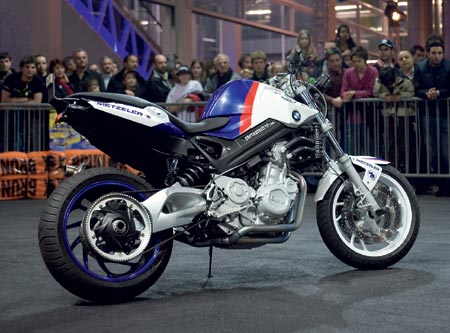• 2006 BMW F800S Stunt
2006 BMW F800S Stunt
SPECTACULAR ARTISTY ON THE NEW BMW F 800 S
Stunt world champion Christian Pfeiffer rides the new 2-cylinder model.
The former stunt world champion Christian Pfeiffer presents his breathtaking motorcycling tricks on the new BMW F 800 S this year. Even in test rides with prototypes last year, Chris Pfeiffer was instantly taken with the playful agility and perfect engine characteristics of the brand new BMW 2-cylinder. BMW Motorrad was happy to oblige when Pfeiffer requested an F 800 as his new "working tool" at the very start of the freestyle season and well before the start of delivery to customers. Christian Pfeiffer was provided with a pre-series model which he modified accordingly.
The new motorcycle came through its baptism of fire in February at the "Stunt Wars" in sunny Florida with flying colours. "Stunt Wars" is the biggest freestyle motorcycle competition in the US and is regarded by pros as the unofficial world championship. 35-year-old Pfeiffer won hands down against the best stunt professionals in the world, with free-hand wheelie circles followed by a 230° turn for example - a feat never seen before. The modified F 800 S was the only 2-cylinder machine in the field - most of the competition used 4-cylinder bikes.Stunt world champion Christian Pfeiffer rides the new 2-cylinder model.
The former stunt world champion Christian Pfeiffer presents his breathtaking motorcycling tricks on the new BMW F 800 S this year. Even in test rides with prototypes last year, Chris Pfeiffer was instantly taken with the playful agility and perfect engine characteristics of the brand new BMW 2-cylinder. BMW Motorrad was happy to oblige when Pfeiffer requested an F 800 as his new "working tool" at the very start of the freestyle season and well before the start of delivery to customers. Christian Pfeiffer was provided with a pre-series model which he modified accordingly.
Pfeiffer was particularly enthusiastic about the F 800's engine characteristics: "The engine is really well connected to the throttle and the power is transmitted spontaneously and sensitively - much better than in my last motorcycle with chain drive. That is exactly what I have always wanted for my stunts - absolutely perfect. From the very beginning I felt good on this bike, the balance is great - I hardly had to do anything to it, almost everything stayed as standard."
Christian Pfeiffer will perform all his stunt appearances in 2006 on the BMW F 800 S. In mid-February, spectators were captivated by his amazing first appearance of 2006 in Europe at the motorcycle trade fair in Zurich where he performed breathtaking tricks on the motorcycle
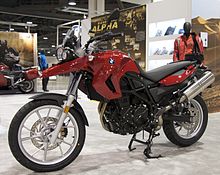
F650GS
Model differences
Although both bikes use the same basic engine, there are a number of differences. The F800 produces 85 hp (63 kW), which is 14 hp (10 kW) more power than the F650. The F650 engine can be modified to deliver just 25 kW (34 hp) for European riders on restricted Category A licences. The F800 is fitted with twin brake discs on the front while the F650 is fitted with just one disc. Both bikes feature optional anti-lock brakes (ABS). The F800 features spoked wheels with a 21 inch front and 17 rear, while the F650 has cast aluminium alloy wheels with a 19 inch front and 17 rear. The standard seat height on the F800 is 880 mm (35 in), compared with 820 mm (32 in) for the F650, which can be further reduced with a low seat and lowered suspension to 765 mm (30.1 in) making it suitable for much shorter riders.A sport bike, also written as sportbike, is a motorcycle optimized for speed, acceleration, braking, and cornering on paved roads, typically at the expense of comfort and fuel economy in comparison to less specialized motorcycles. Soichiro Honda wrote in the owners manual of the 1959 Honda CB92 Benly Super Sport that, "Primarily, essentials of the motorcycle consists in the speed and the thrill," while Cycle World's Kevin Cameron says more prosaically that, "A sportbike is a motorcycle whose enjoyment consists mainly from its ability to perform on all types of paved highway — its cornering ability, its handling, its thrilling acceleration and braking power, even (dare I say it?) its speed."
Motorcycles are versatile and may be put to many uses as the rider sees fit. In the past there were few if any specialized types of motorcycles, but the number of types and sub-types has proliferated, particularly in the period since the 1950s. The introduction of the Honda CB750 in 1969 marked a dramatic increase in the power and speed of practical and affordable sport bikes available to the general public.

The groundbreaking inline four of the Honda CB750.
Design elements
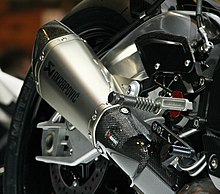
Aftermarket upgrades using carbon fiber or other exotic materials are used on sport bikes to enhance the power-to-weight ratio and handling.
Braking systems combine higher performance brake pads and disc brakes with multi-piston calipers that clamp onto oversized vented rotors. Suspension systems are advanced in terms of adjustments and materials for increased stability and durability. Front and rear tires are larger and wider than tires found on other types of motorcycles to allow higher cornering speeds and greater lean angles. Fairings may or may not be used on a sport bike; when used, fairings are shaped to reduce aerodynamic drag as much as possible and provide wind protection for the rider.
The combination of rider position, location of the engine and other heavy components, and the motorcycle's geometry help maintain structural integrity and chassis rigidity, and determine how it will behave under acceleration, braking, and cornering. Correct front-to-rear weight distribution is of particular importance to the handling of sport bikes, and the changing position of the rider's body dynamically changes the handling of the motorcycle. Because of the complexity of modeling all the possible movements of different sized riders, to approach perfect tuning of a motorcycle's weight distribution and suspension is often only possible by having a bike customized or at least adjusted to fit a specific rider. Generally, road racing style sport bikes have shorter wheelbases than those intended for more comfortable touring, and the current trend in sport bike design is towards shorter wheelbases, giving quicker turning at the expense of a greater tendency for unintentional wheelies and stoppies under hard acceleration and braking, respectively.
Classes
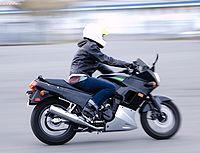
The Kawasaki Ninja 250R lightweight sport bike.

The Triumph Daytona 675 triple is usually classed as a middleweight or supersport.

A Yamaha YZF-R1 998 cc (60.9 cu in) superbike.
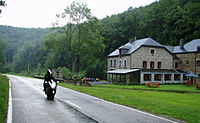
Touring with a passenger on an open class Suzuki Hayabusa.
The sport bike classes in common usage are:
- Lightweight, also called entry level, small or beginner bikes. Some two strokes in this class have dramatically higher performance than the four strokes, being likened to miniature superbikes. Sport bikes with engine displacements of up to about 500 cc (31 cu in) are usually in this class.
- Middleweight, mid-sized, mid-level, or supersport. Some of the models in this range qualify for racing in the classes AMA Supersport Championship, British Supersport Championship and the Supersport World Championship, but many middleweights do not have a significant presence in racing. Displacements of 600–750 cc (37–46 cu in) are typical.
- Superbike, liter-class, or literbike, i.e 1,000 cc (61 cu in). As with supersport, many of the models in this class compete in superbike racing.
- Open class, hypersport or hyperbik are terms sometimes used in lieu of superbike as a catch-all for everything larger than middleweight. Alternatively, these terms mark a class above the superbikes for the largest displacement sport bikes with the highest top speeds, with weights somewhat greater than the supberbike class.
In the less developed world, smaller engine sizes are the norm, and relative terms like small, mid sized and large displacement can have different meanings. For example, in India in 2002 there were about 37 million two-wheelers, but as of 2008, there were only about 3,000 motorcycles, or fewer than one in 12,000, of displacement 1,000 cc (61 cu in) or more. Similarly, the perception of relative sizes has shifted over time in developed countries, from smaller to larger displacements. When the original superbike, the Honda CB750, appeared in 1969, it was called a "big four, while today an inline four of 736.5 cc (44.94 cu in) would be classed in the middle range.
Besides having product lines that span from entry level through high end sport bikes, many manufacturers add depth to that line by having pairs, or several pairs, of similar sport bikes aimed at riders of different levels. These are designed to appeal to riders seeking more or less extreme performance features. The more expensive model will be in the vein of a race replica, offering the latest technology updated with frequent design revisions, while the lower cost model typically relies on older technology, can have a more relaxed riding position, and is generally more practical for non-road racing tasks such as urban commuting and carrying passengers or baggage, and offering lower fuel, insurance and maintenance costs. Examples of these paired models are Buell's Firebolt and Lightning, Ducati's 916/748 through 1198/848 paired series, Honda's CBR600RR and F4i middleweights and RC51 and CBR100RR liter-class, several different concurrent models in Kawasaki's Ninja line, and Yamaha's R6 and 600R.

